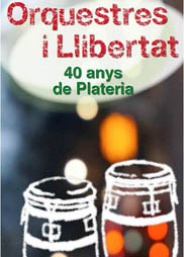Exhibitions
Exhibition loan
The following travelling exhibitions are available, dealing with a variety of popular and traditional culture themes. You can apply to have them shown at your organisation.

The following travelling exhibitions are available, dealing with a variety of popular and traditional culture themes. You can apply to have them shown at your organisation.

Forty years have passed since a dance orchestra set up expressly for the 1974 New Year's Eve celebrations at the Zeleste in Barcelona marked the start of an era, a festive response to the dictatorship. The first really popular festes majors were organised, the neighbourhoods were buzzing and the festivals were an expression of popular roots.
The Orquestra Plateria were the first, the detonator for an era. They were an expression of society at the time and also influenced it. After a while a host of these dance orchestras were created, with different personalities, but they all reinvented the dance festival.
The material on these events and times on display at this exhibition has come from interviewing a number of important witnesses: those involved in setting up and managing the orchestras.

Europe's collective cultural imagination has seen the creation over the centuries of a multi-sided figure around cultures, peoples and elements linked to or detached from the Muslim world. The mixture of political, religious, ethnic, social and cultural elements has given rise to a range of allegorical images about the Moors which jump back and forth between reality and legend. Ballar el Moro [Dancing the Moor] is a journey through history, myths and folklore that surrounds the festival universe of Christians and Moors.
‘Ballar el moro’ explains the mixture of political, religious, ethnic, social and cultural elements that have given rise to a range of allegorical images of the Moor which jump back and forth between reality and legend, between a phobia of and a love for Moors, between history and myth etc.

Fireworks are an essential part of Mediterranean festivals. The release of fireworks, like the chiming of bells, heralds the arrival of the festival while the fire castle represents the highlight of numerous celebrations. You can hear the crack of gunpowder of the early-morning trabucaires [blunderbuss-wielding groups in period costume] while the dance parades, the sparkling flares of the diables [fire-running devils] and the fire of the beasts transform the city night and offer a participatory fire games...
This exhibition offers a close-up view of fireworks, of the work carried out by the men and women who prepare festival devices, and of their use during the festival. A view of the professionals who put together the gunpowder and the devices that have made fire castles for centuries the festival show par excellence. A view of the individual and group use of fireworks. A view of the thunderstorms and secular representations of good against evil, of the fantastic beasts that fill the fire streets. A view of the casings that sketch spectacular, ephemeral images in the sky. Of the fire-runs.